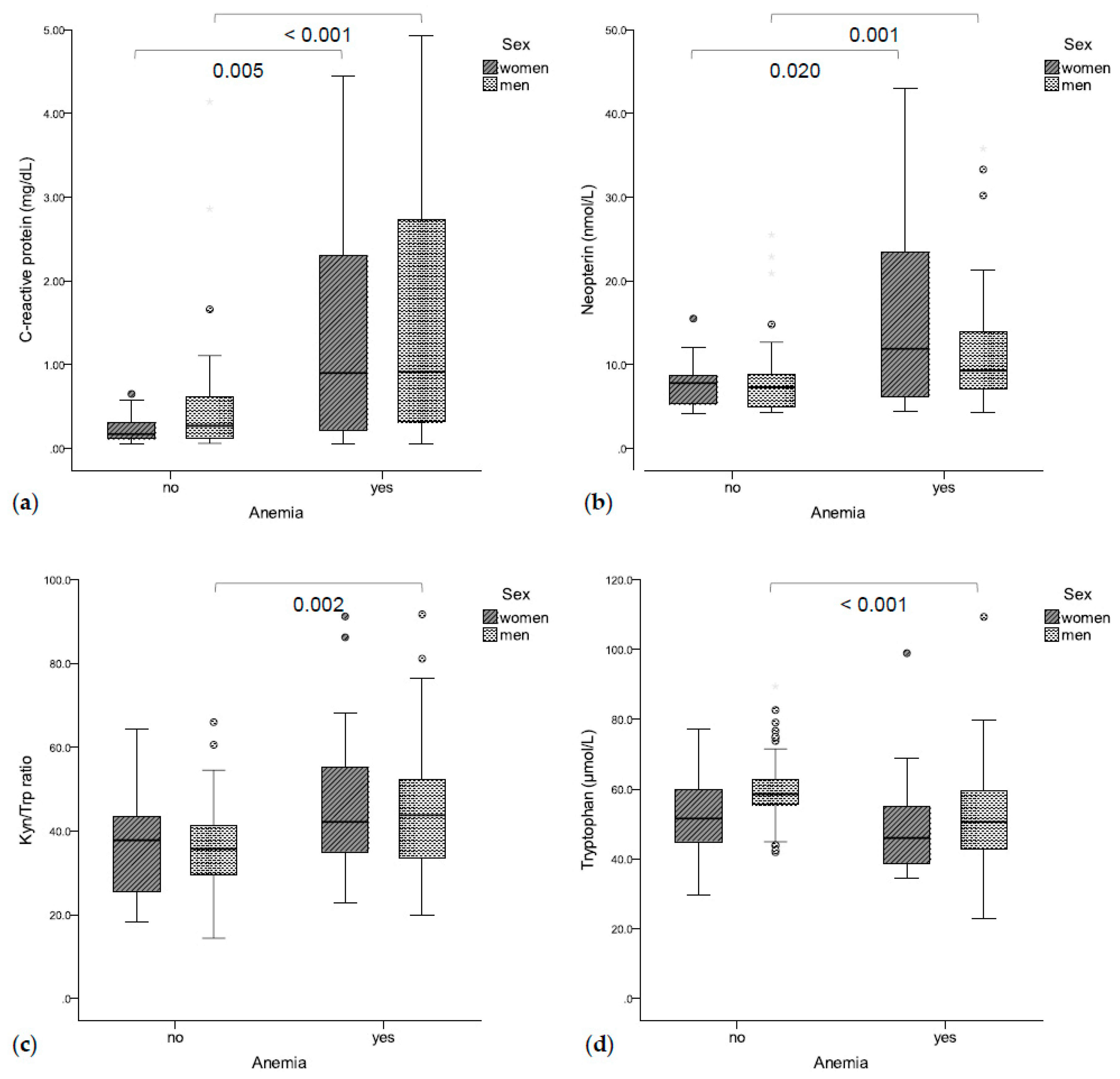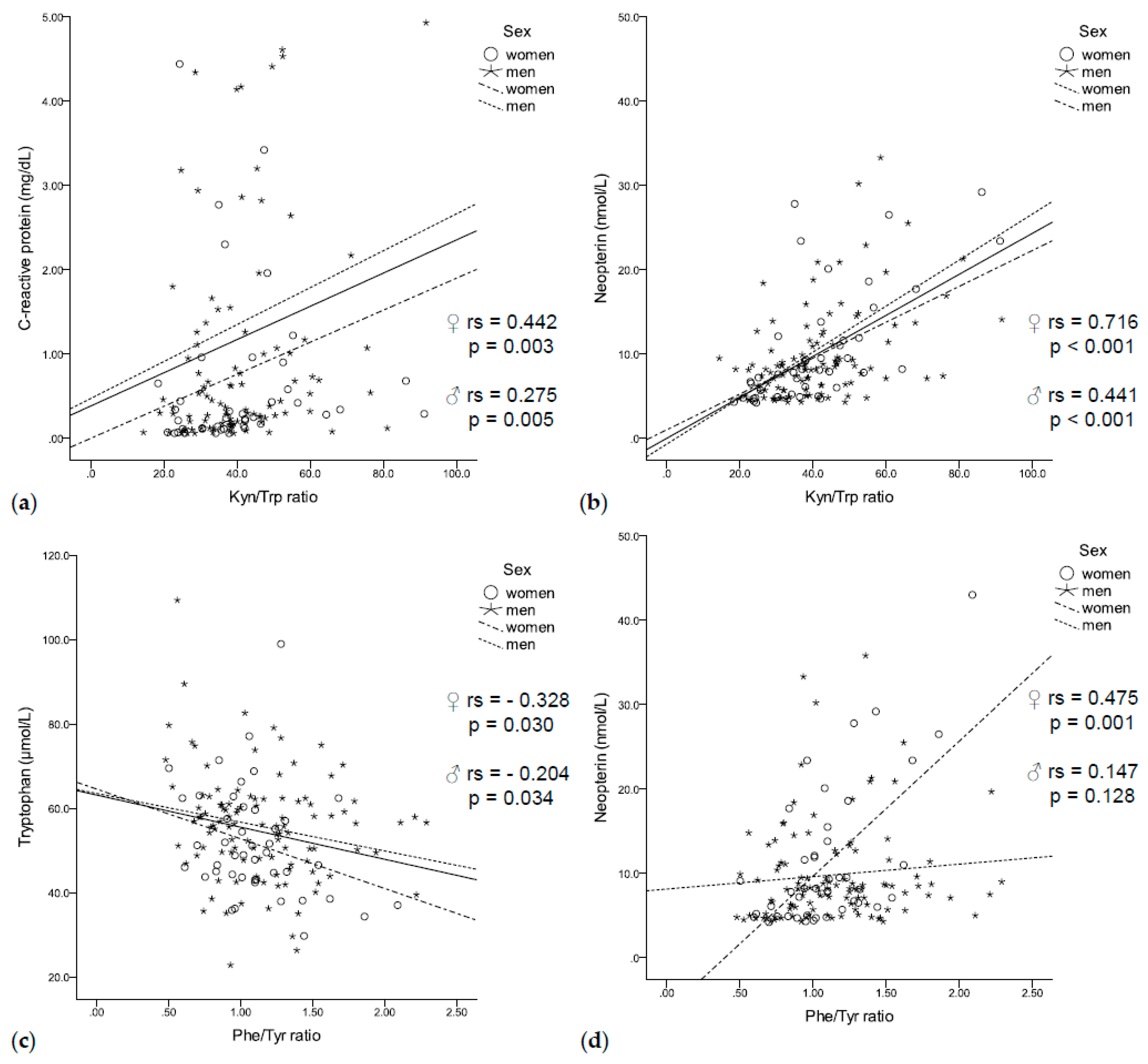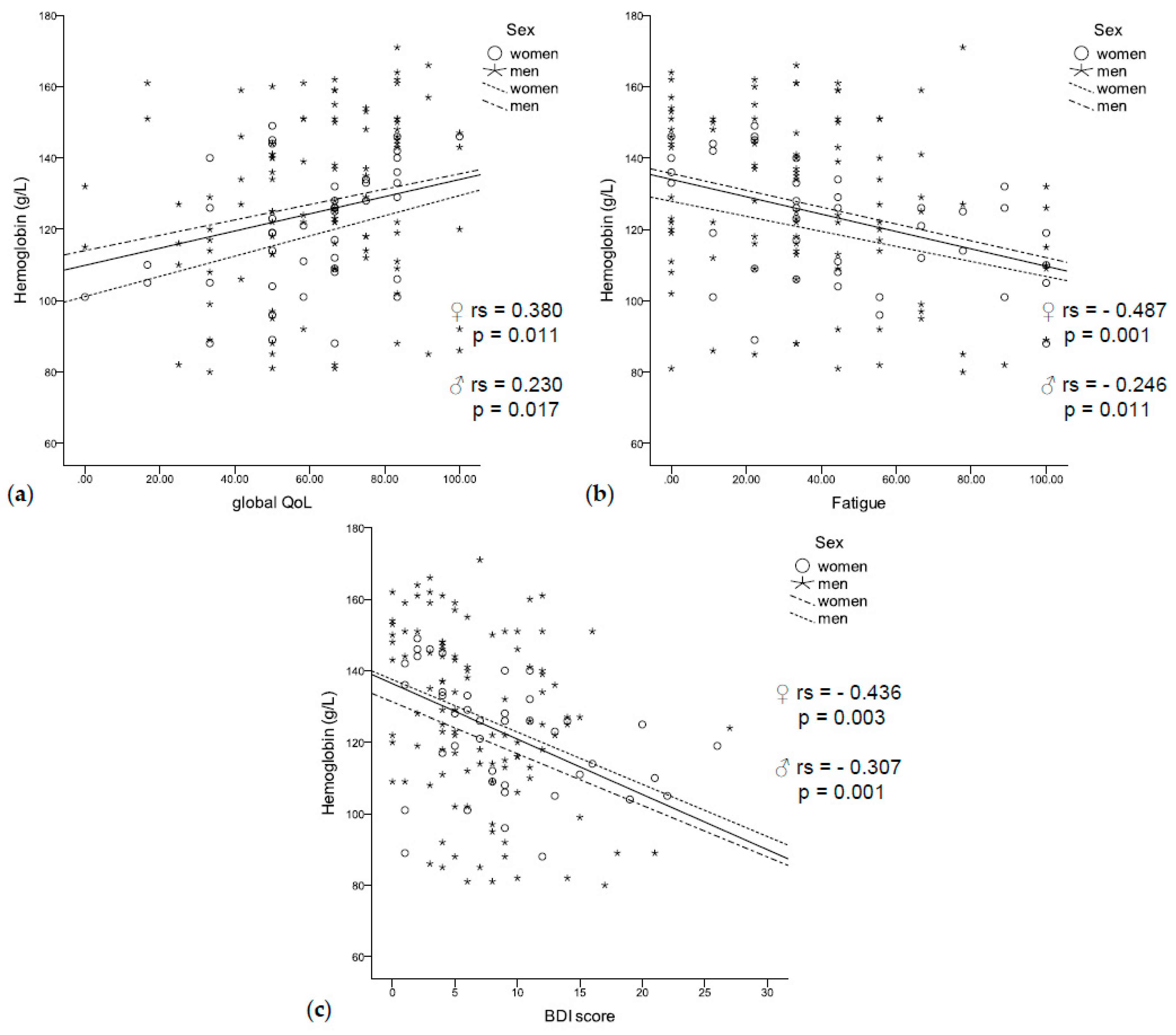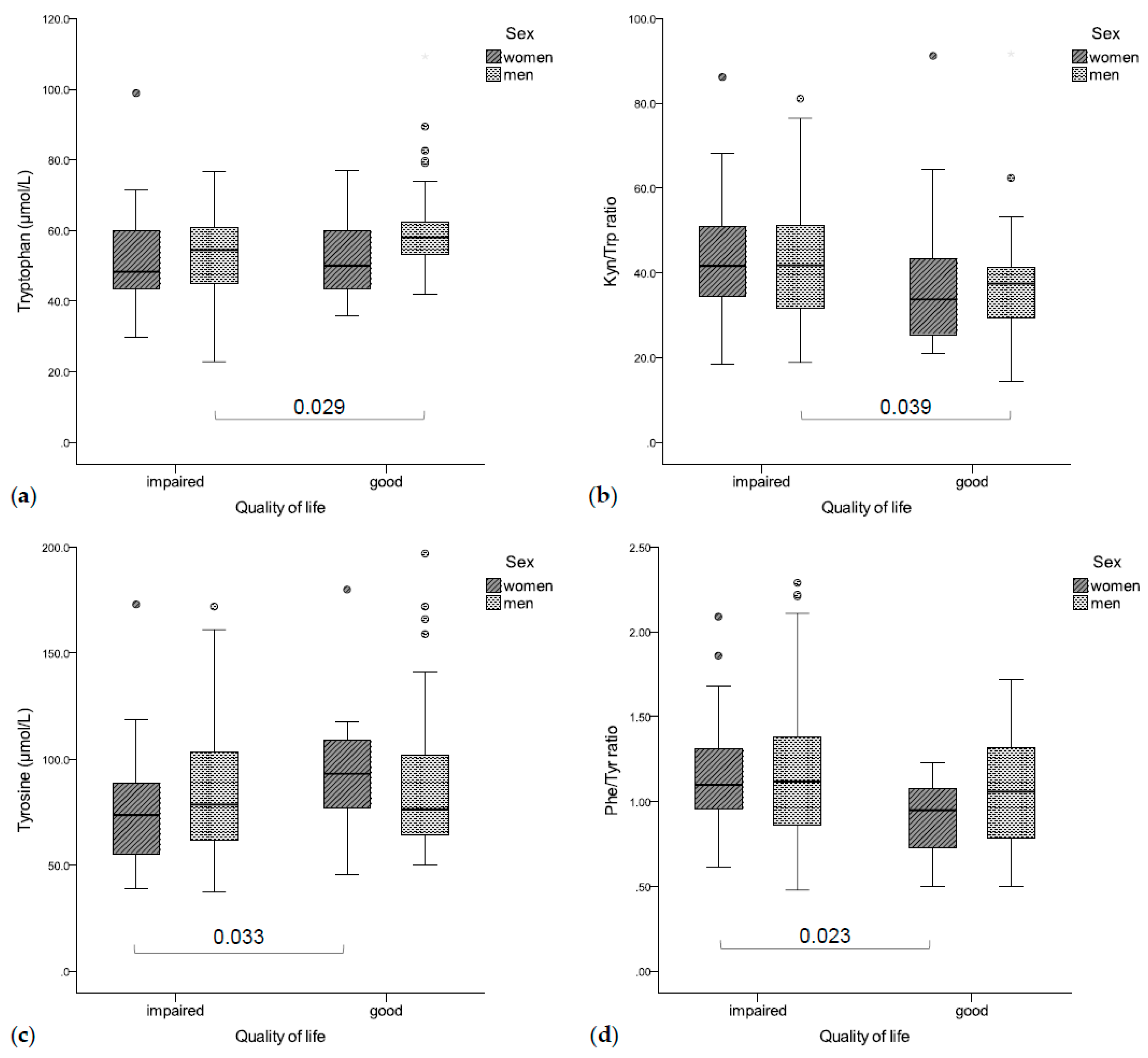Immune Activation and Anemia Are Associated with Decreased Quality of Life in Patients with Solid Tumors
Abstract
1. Introduction
2. Materials and Methods
2.1. Study Population
2.2. Assessment of Quality of Life and Depression
2.3. Laboratory Examinations
2.4. Tumor Classifications
2.5. Statistical Analysis
3. Results
3.1. Anemia Coincides with Immune-Mediated Tryptophan Degradation
3.2. Inflammation, Tryptophan, and Phenylalanine Metabolism in Patients with Solid Tumors
3.3. Immune-Mediated Tryptophan Degradation and Phenylalanine Accumulation
3.4. Quality of Life and Depression
3.5. Relationship between Anemia, Impaired Quality of Life, Fatigue, and Depression
3.6. Immune-Mediated Changes in Tryptophan and Phenylalanine Metabolism Are Associated with an Impaired Quality of Life, Decreased Physical Functioning, Fatigue, and Depression
3.7. Therapy, Quality of Life and Depression
4. Discussion
Strengths and Limitations
5. Conclusions
Author Contributions
Funding
Conflicts of Interest
References
- Gaspar, B.L.; Sharma, P.; Das, R. Anemia in malignancies: Pathogenetic and diagnostic considerations. Hematology 2014, 20, 18–25. [Google Scholar] [CrossRef]
- Madeddu, C.; Gramignano, G.; Astara, G.; Demontis, R.; Sanna, E.; Atzeni, V.; Macciò, A. Pathogenesis and Treatment Options of Cancer Related Anemia: Perspective for a Targeted Mechanism-Based Approach. Front. Physiol. 2018, 9, 9. [Google Scholar] [CrossRef] [PubMed]
- Curt, G.A. Impact of fatigue on quality of life in oncology patients. Semin. Hematol. 2000, 37, 14–17. [Google Scholar] [CrossRef]
- Pirl, W.F. Evidence report on the occurrence, assessment, and treatment of depression in cancer patients. J. Natl. Cancer Inst. Monogr. 2004, 2004, 32–39. [Google Scholar] [CrossRef] [PubMed]
- Linden, W.; Vodermaier, A.; MacKenzie, R.; Greig, D. Anxiety and depression after cancer diagnosis: Prevalence rates by cancer type, gender, and age. J. Affect. Disord. 2012, 141, 343–351. [Google Scholar] [CrossRef]
- Weitzner, M.A.; Meyers, C.A.; Stuebing, K.K.; Saleeba, A.K. Relationship between quality of life and mood in long-term survivors of breast cancer treated with mastectomy. Support. Care Cancer 1997, 5, 241–248. [Google Scholar] [CrossRef] [PubMed]
- Cohen, L.; De Moor, C.; Amato, R.J. The association between treatment-specific optimism and depressive symptomatology in patients enrolled in a Phase I cancer clinical trial. Cancer 2001, 91, 1949–1955. [Google Scholar] [CrossRef]
- Newport, D.J.; Nemeroff, C.B. Assessment and treatment of depression in the cancer patient. J. Psychosom. Res. 1998, 45, 215–237. [Google Scholar] [CrossRef]
- Spiegel, D. Cancer and depression. Br. J. Psychiatry Suppl. 1996, 168, 109–116. [Google Scholar] [CrossRef]
- Bukberg, J.; Penman, D.; Holland, J.C. Depression in Hospitalized Cancer Patients. Psychosom. Med. 1984, 46, 199–212. [Google Scholar] [CrossRef]
- Spiegel, D.; Sands, S.; Koopman, C. Pain and depression in patients with cancer. Cancer 1994, 74, 2570–2578. [Google Scholar] [CrossRef]
- Fuchs, D.; Hausen, A.; Reibnegger, G.; Werner, E.R.; Werner-Felmayer, G.; Dierich, M.P.; Wachter, H. Immune activation and the anaemia associated with chronic inflammatory disorders. Eur. J. Haematol. 1991, 46, 65–70. [Google Scholar] [CrossRef] [PubMed]
- Kurz, K.; Fiegl, M.; Holzner, B.; Giesinger, J.M.; Pircher, M.; Weiss, G.; Denz, H.A.; Fuchs, D. Fatigue in Patients with Lung Cancer Is Related with Accelerated Tryptophan Breakdown. PLoS ONE 2012, 7, e36956. [Google Scholar] [CrossRef] [PubMed]
- Lanser, L.; Kink, P.; Egger, E.M.; Willenbacher, W.; Fuchs, D.; Weiss, G.; Kurz, K. Inflammation-Induced Tryptophan Breakdown is Related With Anemia, Fatigue, and Depression in Cancer. Front. Immunol. 2020, 11, 11. [Google Scholar] [CrossRef]
- Weiss, G.; Schroecksnadel, K.; Mattle, V.; Winkler, C.; Konwalinka, G.; Fuchs, D. Possible role of cytokine-induced tryptophan degradation in anaemia of inflammation. Eur. J. Haematol. 2004, 72, 130–134. [Google Scholar] [CrossRef]
- Wenninger, J.; Meinitzer, A.; Holasek, S.; Schnedl, W.J.; Zelzer, S.; Mangge, H.; Herrmann, M.; Enko, D. Associations between tryptophan and iron metabolism observed in individuals with and without iron deficiency. Sci. Rep. 2019, 9, 1–9. [Google Scholar] [CrossRef]
- Werner, E.R.; Bitterlich, G.; Fuchs, D.; Hausen, A.; Reibnegger, G.; Szabo, G.; Dierich, M.P.; Wachter, H. Human macrophages degrade tryptophan upon induction by interferon-gamma. Life Sci. 1987, 41, 273–280. [Google Scholar] [CrossRef]
- Schröcksnadel, K.; Wirleitner, B.; Winkler, C.; Fuchs, D. Monitoring tryptophan metabolism in chronic immune activation. Clin. Chim. Acta 2006, 364, 82–90. [Google Scholar] [CrossRef]
- Badawy, A.A.-B.; Guillemin, G.J. The Plasma [Kynurenine]/[Tryptophan] Ratio and Indoleamine 2,3-Dioxygenase: Time for Appraisal. Int. J. Tryptophan Res. 2019, 12, 1178646919868978. [Google Scholar] [CrossRef]
- Capuron, L.; Miller, A.H. Immune system to brain signaling: Neuropsychopharmacological implications. Pharmacol. Ther. 2011, 130, 226–238. [Google Scholar] [CrossRef]
- Amireault, P.; Hatia, S.; Bayard, E.; Bernex, F.; Collet, C.; Callebert, J.; Launay, J.-M.; Hermine, O.; Schneider, E.; Mallet, J.; et al. Ineffective erythropoiesis with reduced red blood cell survival in serotonin-deficient mice. Proc. Natl. Acad. Sci. USA 2011, 108, 13141–13146. [Google Scholar] [CrossRef] [PubMed]
- Uyttenhove, C.; Pilotte, L.; Théate, I.; Stroobant, V.; Colau, D.; Parmentier, N.; Boon, T.; Eynde, B.V.D. Evidence for a tumoral immune resistance mechanism based on tryptophan degradation by indoleamine 2,3-dioxygenase. Nat. Med. 2003, 9, 1269–1274. [Google Scholar] [CrossRef] [PubMed]
- Carlin, J.M.; Ozaki, Y.; Byrne, G.I.; Brown, R.R.; Borden, E.C. Interferons and indoleamine 2,3-dioxygenase: Role in antimicrobial and antitumor effects. Cell. Mol. Life Sci. 1989, 45, 535–541. [Google Scholar] [CrossRef] [PubMed]
- Widner, B.; Laich, A.; Sperner-Unterweger, B.; Ledochowski, M.; Fuchs, D. Neopterin production, tryptophan degradation, and mental depression—What is the link? Brain Behav. Immun. 2002, 16, 590–595. [Google Scholar] [CrossRef]
- Maes, M.; Scharpe, S.; Meltzer, H.Y.; Okayli, G.; Bosmans, E.; D’Hondt, P.; Bossche, B.V.; Cosyns, P. Increased neopterin and interferon-gamma secretion and lower availability of L-tryptophan in major depression: Further evidence for an immune response. Psychiatry Res. Neuroimaging 1994, 54, 143–160. [Google Scholar] [CrossRef]
- Huang, A.; Fuchs, D.; Widner, B.; Glover, C.; Henderson, D.C.; Allen-Mersh, T.G. Serum tryptophan decrease correlates with immune activation and impaired quality of life in colorectal cancer. Br. J. Cancer 2002, 86, 1691–1696. [Google Scholar] [CrossRef] [PubMed]
- Dantzer, R.; Heijnen, C.J.; Kavelaars, A.; Layé, S.; Capuron, L. The neuroimmune basis of fatigue. Trends Neurosci. 2013, 37, 39–46. [Google Scholar] [CrossRef]
- Murr, C.; Widner, B.; Wirleitner, B.; Fuchs, D. Neopterin as a marker for immune system activation. Curr. Drug Metab. 2002, 3, 175–187. [Google Scholar] [CrossRef]
- Kurz, K.; Schroecksnadel, S.; Weiss, G.; Fuchs, D. Association between increased tryptophan degradation and depression in cancer patients. Curr. Opin. Clin. Nutr. Metab. Care 2011, 14, 49–56. [Google Scholar] [CrossRef]
- Dantzer, R.; O’Connor, J.C.; Lawson, M.A.; Kelley, K.W. Inflammation-associated depression: From serotonin to kynurenine. Psychoneuroendocrinology 2011, 36, 426–436. [Google Scholar] [CrossRef]
- Heyes, M.P.; Saito, K.; Crowley, J.S.; Davis, L.E.; Demitrack, M.A.; Der, M.; Dilling, L.A.; Elia, J.; Kruesi, M.J.P.; Lackner, A.; et al. Quinolinic acid and kynurenine pathway metabolism in inflammatory and non-inflammatory neurological disease. Brain 1992, 115, 1249–1273. [Google Scholar] [CrossRef] [PubMed]
- Maes, M.; Galecki, P.; Verkerk, R.M.; Rief, W. Somatization, but not depression, is characterized by disorders in the tryptophan catabolite (TRYCAT) pathway, indicating increased indoleamine 2,3-dioxygenase and lowered kynurenine aminotransferase activity. Neuro Endocrinol. Lett. 2011, 32, 264–273. [Google Scholar] [PubMed]
- Owens, M.J.; Nemeroff, C.B. Role of serotonin in the pathophysiology of depression: Focus on the serotonin transporter. Clin. Chem. 1994, 40, 288–295. [Google Scholar] [CrossRef] [PubMed]
- Neurauter, G.; Schrocksnadel, K.; Scholl-Burgi, S.; Sperner-Unterweger, B.; Schubert, C.; Ledochowski, M.; Fuchs, D. Chronic immune stimulation correlates with reduced phenylalanine turnover. Curr. Drug Metab. 2008, 9, 622–627. [Google Scholar] [CrossRef] [PubMed]
- Shintaku, H. Disorders of tetrahydrobiopterin metabolism and their treatment. Curr. Drug Metab. 2002, 3, 123–131. [Google Scholar] [CrossRef] [PubMed]
- Schroecksnadel, K.; Fiegl, M.; Prassl, K.; Winkler, C.; Denz, H.A.; Fuchs, D. Diminished quality of life in patients with cancer correlates with tryptophan degradation. J. Cancer Res. Clin. Oncol. 2007, 133, 477–485. [Google Scholar] [CrossRef]
- Aaronson, N.K.; Ahmedzai, S.; Bergman, B.; Bullinger, M.; Cull, A.; Duez, N.J.; Filiberti, A.; Flechtner, H.; Fleishman, S.B.; De Haes, J.C.; et al. The European Organization for Research and Treatment of Cancer QLQ-C30: A Quality-of-Life Instrument for Use in International Clinical Trials in Oncology. J. Natl. Cancer Inst. 1993, 85, 365–376. [Google Scholar] [CrossRef]
- Fayers, P.A.N.; Bjordal, K.; Groenvold, M.; Curran, D.; Bottomley, A. The EORTC QLQ-C30 Scoring Manual, 3rd ed.; European Organisation for Research and Treatment of Cancer: Brussels, Belgium, 2001. [Google Scholar]
- Widner, B.; Werner, E.R.; Schennach, H.; Wachter, H.; Fuchs, D. Simultaneous Measurement of Serum Tryptophan and Kynurenine by HPLC. Clin. Chem. 1997, 43, 2424–2426. [Google Scholar] [CrossRef]
- Neurauter, G.; Scholl-Bürgi, S.; Haara, A.; Geisler, S.; Mayersbach, P.; Schennach, H.; Fuchs, D. Simultaneous measurement of phenylalanine and tyrosine by high performance liquid chromatography (HPLC) with fluorescence detection. Clin. Biochem. 2013, 46, 1848–1851. [Google Scholar] [CrossRef]
- Brierley, J.; Gospodarowicz, M.K.; Wittekind, C. Union for International Cancer Control. In TNM Classification of Malignant Tumours; Wiley: New York, NY, USA, 2017. [Google Scholar]
- Geisler, S.; Mayersbach, P.; Becker, K.; Schennach, H.; Fuchs, D.; Gostner, J.M. Serum tryptophan, kynurenine, phenylalanine, tyrosine and neopterin concentrations in 100 healthy blood donors. Pteridines 2015, 26, 31–36. [Google Scholar] [CrossRef]
- Schwarz, R.; Hinz, A. Reference data for the quality of life questionnaire EORTC QLQ-C30 in the general German population. Eur. J. Cancer 2001, 37, 1345–1351. [Google Scholar] [CrossRef]
- Reininghaus, E.; Dalkner, N.; Riedrich, K.; Fuchs, D.; Gostner, J.M.; Reininghaus, B. Sex Specific Changes in Tryptophan Breakdown Over a 6 Week Treatment Period. Front. Psychiatry 2019, 10, 74. [Google Scholar] [CrossRef] [PubMed]
- Moursi, G.E.; Abdel-Daim, M.H.; Kelada, N.L.; Abdel-Tawab, G.A.; Girgis, L.H. The influence of sex, age, synthetic oestrogens, progestogens and oral contraceptives on the excretion of urinary tryptophan metabolites. Bull. World Health Organ. 1970, 43, 651–661. [Google Scholar] [PubMed]
- Rose, D.P.; Braidman, I.P. Excretion of tryptophan metabolites as affected by pregnancy, contraceptive steroids, and steroid hormones. Am. J. Clin. Nutr. 1971, 24, 673–683. [Google Scholar] [CrossRef] [PubMed]
- Schröcksnadel, K.; Widner, B.; Neurauter, G.; Fuchs, D.; Schröcksnadel, H.; Bergant, A. Tryptophan Degradation during and after Gestation. Adv. Exp. Med. Biol. 2003, 527, 77–83. [Google Scholar] [CrossRef]
- Hüfner, K.; Oberguggenberger, A.; Kohl, C.; Geißler, S.; Gamper, E.; Meraner, V.; Egeter, J.; Hubalek, M.; Beer, B.; Fuchs, D.; et al. Levels in neurotransmitter precursor amino acids correlate with mental health in patients with breast cancer. Psychoneuroendocrinology 2015, 60, 28–38. [Google Scholar] [CrossRef]
- Melichar, B.; Solichova, D.; Freedman, R. Neopterin as an indicator of immune activation and prognosis in patients with gynecological malignancies. Int. J. Gynecol. Cancer 2006, 16, 240–252. [Google Scholar] [CrossRef]
- Weiss, G.; Kronberger, P.; Conrad, F.; Bodner, E.; Wachter, H.; Reibnegger, G. Neopterin and prognosis in patients with adenocarcinoma of the colon. Cancer Res. 1993, 53, 260–265. [Google Scholar]
- Murr, C.; Bergant, A.; Widschwendter, M.; Heim, K.; Schröcksnadel, H.; Fuchs, D. Neopterin Is an Independent Prognostic Variable in Females with Breast Cancer. Clin. Chem. 1999, 45, 1998–2004. [Google Scholar] [CrossRef]
- Huang, J.Y.; LaRose, T.L.; Luu, H.N.; Wang, R.; Fanidi, A.; Alcala, K.; Stevens, V.L.; Weinstein, S.J.; Albanes, D.; Caporaso, N.E.; et al. Circulating markers of cellular immune activation in prediagnostic blood sample and lung cancer risk in the Lung Cancer Cohort Consortium (LC3). Int. J. Cancer 2019, 146, 2394–2405. [Google Scholar] [CrossRef]
- Gonzalez, H.; Hagerling, C.; Werb, Z. Roles of the immune system in cancer: From tumor initiation to metastatic progression. Genes Dev. 2018, 32, 1267–1284. [Google Scholar] [CrossRef] [PubMed]




| Total | Women | Men | Reference | |
|---|---|---|---|---|
| n = 152 | n = 44 | n = 108 | [42] | |
| Median or n (%) | Median or n (%) | Median or n (%) | Median | |
| Age | ||||
| <65 years | 89 (58.6) | 28 (63.6) | 61 (56.5) | |
| ≥65 years | 63 (41.4) | 16 (36.4) | 47 (43.5) | |
| UICC stage | ||||
| I | 16 (10.8) | 1 (2.3) | 15 (14.3) | |
| II | 23 (15.5) | 5 (11.6) | 18 (17.1) | |
| III | 48 (32.4) | 12 (27.9) | 36 (34.3) | |
| IV | 61 (41.2) | 25 (58.1) | 36 (34.3) | |
| Current treatment strategy | ||||
| Adjuvant | 61 (40.1) | 19 (43.2) | 42 (38.9) | |
| Palliative | 49 (32.2) | 15 (34.1) | 34 (31.5) | |
| No treatment | 42 (27.6) | 10 (22.7) | 32 (29.6) | |
| Previous treatment | 126 (82.9) | 38 (86.4) | 88 (81.5) | |
| Prior surgery | 92 (60.5) | 24 (54.5) | 68 (63.0) | |
| Prior chemotherapy | 94 (61.8) | 30 (68.2) | 64 (59.3) | |
| Prior radiotherapy | 46 (30.3) | 16 (36.4) | 30 (27.8) | |
| Tumor localization | ||||
| Gastrointestinal cancer 1 | 65 (42.8) | 16 (36.4) | 49 (45.4) | |
| Lung cancer 2 | 49 (32.2) | 18 (40.9) | 31 (28.7) | |
| ENT cancer 3 | 8 (5.3) | 0 (0.0) | 8 (7.4) | |
| Sarcoma 4 | 13 (8.6) | 1 (2.3) | 12 (11.1) | |
| Tumor of other primary 5 | 17 (11.2) | 9 (20.4) | 8 (7.4) | |
| Laboratory measurements | ||||
| CRP (mg/dL) | 0.37 | 0.29 | 0.46 | ≤0.50 |
| WBC (g/L) | 6.5 | 6.3 | 6.7 | 4.0–10.0 |
| Hemoglobin (g/L) | 125 | 122 | 127 | ≥120 (m) |
| ≥130 (w) | ||||
| Neopterin (nmol/L) | 8.2 | 8.0 | 8.2 | 4.96 |
| Tryptophan (μmol/L) | 54.8 | 48.9 | 56.2 | 66.8 |
| Kynurenine (μmol/L) | 2.07 | 1.96 | 2.10 | 1.72 |
| Kyn/Trp (μmol/mmol) | 38.4 | 38.0 | 38.6 | 26.0 |
| Phenylalanine (μmol/L) | 83.3 | 79.8 | 87.2 | 64.1 |
| Tyrosine (μmol/L) | 76.8 | 76.7 | 76.9 | 87.8 |
| Phe/Tyr (μmol/μmol) | 1.09 | 1.07 | 1.10 | 0.74 |
| Mean ± SD | Reference ± SD | above/below Reference Value [%] | |
|---|---|---|---|
| Global health status/Quality of life | 61.5 ± 22.0 | 70.8 ± 22.1 | |
| Functional scales | |||
| Physical functioning | 74.1 ± 23.2 | 90.1 ± 16.7 | 63.2 |
| Role functioning | 61.5 ± 34.8 | 88.0 ± 22.9 | 68.4 |
| Emotional functioning | 77.3 ± 22.9 | 78.7 ± 21.0 | 42.1 |
| Cognitive functioning | 84.9 ± 19.9 | 91.2 ± 17.0 | 49.3 |
| Social functioning | 69.2 ± 32.3 | 91.0 ± 19.4 | 62.5 |
| Symptom scales | |||
| Fatigue | 38.9 ± 29.9 | 17.1 ± 22.0 | 75.0 |
| Nausea and vomiting | 12.8 ± 22.1 | 2.8 ± 9.9 | 36.2 |
| Pain | 26.2 ± 30.8 | 15.4 ± 24.4 | 56.6 |
| Dyspnea | 26.9 ± 32.1 | 8.1 ± 20.3 | 50.0 |
| Insomnia | 24.3 ± 30.3 | 16.4 ± 27.2 | 46.7 |
| Appetite loss | 21.9 ± 31.9 | 5.4 ± 16.0 | 38.8 |
| Constipation | 15.9 ± 27.7 | 3.6 ± 13.7 | 30.3 |
| Diarrhea | 12.5 ± 25.4 | 2.8 ± 11.7 | 25.0 |
| Financial difficulties | 19.1 ± 30.5 | 6.0 ± 18.2 | 32.9 |
© 2020 by the authors. Licensee MDPI, Basel, Switzerland. This article is an open access article distributed under the terms and conditions of the Creative Commons Attribution (CC BY) license (http://creativecommons.org/licenses/by/4.0/).
Share and Cite
Kink, P.; Egger, E.M.; Lanser, L.; Klaunzner, M.; Holzner, B.; Willenbacher, W.; Kasseroler, M.T.; Fuchs, D.; Weiss, G.; Kurz, K. Immune Activation and Anemia Are Associated with Decreased Quality of Life in Patients with Solid Tumors. J. Clin. Med. 2020, 9, 3248. https://doi.org/10.3390/jcm9103248
Kink P, Egger EM, Lanser L, Klaunzner M, Holzner B, Willenbacher W, Kasseroler MT, Fuchs D, Weiss G, Kurz K. Immune Activation and Anemia Are Associated with Decreased Quality of Life in Patients with Solid Tumors. Journal of Clinical Medicine. 2020; 9(10):3248. https://doi.org/10.3390/jcm9103248
Chicago/Turabian StyleKink, Patricia, Eva Maria Egger, Lukas Lanser, Michaela Klaunzner, Bernhard Holzner, Wolfgang Willenbacher, Maria Theresia Kasseroler, Dietmar Fuchs, Günter Weiss, and Katharina Kurz. 2020. "Immune Activation and Anemia Are Associated with Decreased Quality of Life in Patients with Solid Tumors" Journal of Clinical Medicine 9, no. 10: 3248. https://doi.org/10.3390/jcm9103248
APA StyleKink, P., Egger, E. M., Lanser, L., Klaunzner, M., Holzner, B., Willenbacher, W., Kasseroler, M. T., Fuchs, D., Weiss, G., & Kurz, K. (2020). Immune Activation and Anemia Are Associated with Decreased Quality of Life in Patients with Solid Tumors. Journal of Clinical Medicine, 9(10), 3248. https://doi.org/10.3390/jcm9103248





